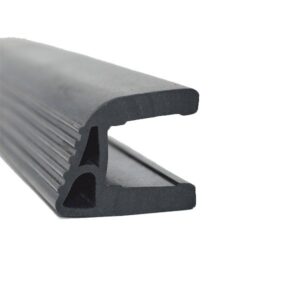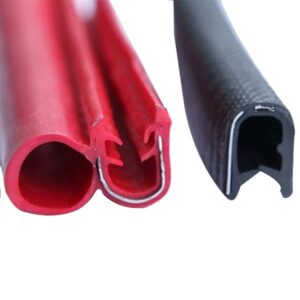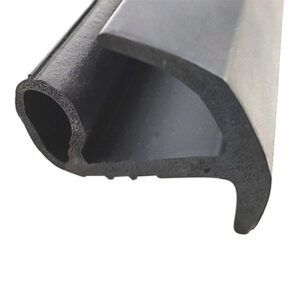What Are Rubber Seal Strips?
A rubber seal strip (also called weather stripping) is an extruded profile made from elastomeric materials—most commonly EPDM, NBR, or silicone. By compressing into gaps between fixed and moving components, these strips block unwanted air, water, dust, noise, and even light. You’ll find them around doors, windows, machinery housings, automotive windshields, rail car doors, marine hatches, and cabinet edges.
How They Work:
- When installed, the strip’s flexible “lip” or “bulb” deforms under pressure, creating a tight barrier.
- The elastic rebound maintains continuous sealing even after repeated motion.
- Special foam cores add cushioning and thermal insulation.
Core Benefits & Material Comparison
| Benefit | Description |
| Air & Water Tightness | Prevents drafts, water leaks, and energy loss in HVAC systems—cutting heating/cooling costs by up to 15%. |
| Durability & Aging Resistance | EPDM resists UV, ozone, and extreme temperatures (‑40 °C to 120 °C); NBR excels with oil and fuel resistance; silicone stays flexible up to 200 °C. |
| Noise & Vibration Dampening | Foam‑backed seals absorb vibration and reduce noise transmission in vehicles, machinery, and building partitions. |
| Custom Profiles & Colors | Single‑layer, co‑extruded, or foam versions in any cross‑sectional shape; optional stainless‑steel or PVC inserts for reinforcement; available in black, gray, white, or custom hues. |
| Fire & Chemical Resistance | UL94‑VO rated options, flame‑retardant EPDM blends, and chemical‑resistant NBR grades safeguard rail cars, marine vessels, and industrial equipment. |
Material & Manufacturing Overview

1. EPDM (Ethylene Propylene Diene Monomer)
- Excellent UV/ozone/weather resistance
- Temperature range: –40 °C to +120 °C
- Ideal for outdoor, automotive, and building seals
2. NBR (Nitrile Butadiene Rubber)
- Superior oil, fuel, and chemical resistance
- Temperature range: –30 °C to +100 °C
- Common in engine compartments, hydraulic equipment
3. Silicone

- Extreme temperature stability (–60 °C to +200 °C)
- Food‑grade and medical‑grade options
- Used in ovens, medical devices, and high‑heat applications
4. Foam Rubber (Closed‑cell)
- Lightweight, compressible, thermal insulator
- Reduces vibration and sound
- Used in doors, windows, HVAC ducts
Manufacturing Processes:
- Single‑extrusion: one material flows through a single die.
- Co‑extrusion: two or more materials combined in one profile (e.g., EPDM + foam).
- Foam extrusion: chemical blowing agents create closed‑cell structure in‑line.
Top 5 Application Scenarios
1. Building & Windows
Weather stripping for doors and windows reduces heating/cooling bills, blocks dust, insects, and noise. Typical profiles include P‑channel, D‑shape, and bulb seals.
2. Automotive Sealing
Profiles for windshields, doors, trunk lids, engine compartments. Must resist high speeds, road grime, UV, and temperature cycling.
3. Rail & Metro
Fire‑rated, low‑smoke seals for carriage doors and windows. Comply with EN 45545, NFPA 130 standards for passenger safety.
4. Marine & Container Doors
Corrosion‑proof EPDM and silicone strips protect against seawater, salt spray, and UV. J‑shape and V‑shape profiles ensure watertight hatches.
5. Cabinets & Appliances
Closed‑cell foam seals for refrigeration, cabinetry, and equipment enclosures. Provide dust, moisture barrier and cushioning.
How to Select the Right Seal Strip

- Identify Environment: indoor vs. outdoor, temperature range, chemical exposure.
- Choose Material: EPDM for weather, NBR for oil, silicone for heat.
- Measure Gap Width & Compression: ensure proper interference fit (10–30% compression).
- Profile Shape: bulb, P‑channel, D‑shape, J‑shape—match mounting groove or flange.
- Certifications: ISO 9001, IATF 16949, UL94‑VO, RoHS for your industry requirements.
Tip: Request free samples to test fit and performance before bulk ordering.
Installation & Maintenance Tips
- Surface Preparation: clean and dry mounting surfaces; remove old adhesive residue.
- Adhesive Backing: peel‑and‑stick strips require 24 hr cure for full bond.
- Mechanical Fastening: use clips or screws for high‑stress applications.
- Periodic Inspection: check for wear, cracks, or compression set every 6–12 months.
- Replacement: change seals showing >20% compression set or visible damage.
Why Choose OKIN Seal Strips?

- 21 Production Lines (6 co‑extrusion, 3 foam) → Fast lead times
- International Certifications: ISO 9001, IATF 16949, UL94‑VO, RoHS → Guaranteed quality
- Global Export: Serving 30+ countries across Southeast Asia, Europe, Middle East, North America
- Expert Support: 24/7 technical assistance, free custom design, rapid sampling
Connect us to request your free sample today! Rubber seal strips are crucial for energy efficiency, equipment longevity, and safety across multiple industries. By selecting the right material and profile—and partnering with a certified expert like OKIN—you ensure leak‑proof, durable performance under the harshest conditions.
